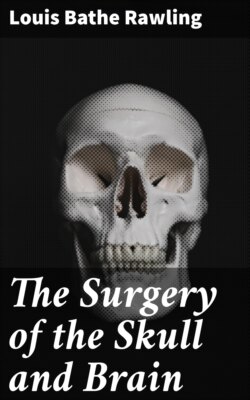Читать книгу The Surgery of the Skull and Brain - Louis Bathe Rawling - Страница 60
На сайте Литреса книга снята с продажи.
Course and treatment.
ОглавлениеIt is often stated that these depressed fractures remedy themselves in the course of time, the development of the underlying cortex curing the depression by the outward leverage exerted. In the minor degrees of depression there may be some chance of such spontaneous cure. I am, however, entirely opposed to the view that spontaneous cure is the rule, and there can be no question that the more severe types of depression remain as permanent defects unless surgical remedies are adopted. Furthermore, even if the deformity should cure itself in time, the intermediate dangers are not to be disregarded, for, during the process of spontaneous cure, there is a decided liability for the depressed cortex to lag behind in the process of development, or to undergo degenerative changes as the result of the pressure exerted—with disastrous results on the parts supplied by the region compressed. Mental deficiency, paralyses, and contractures will result, and there is every reason to believe that some cases of infantile paralysis are dependent on this lesion.
The following case, recently under my care, adds further proof to the statement that spontaneous cure is usually out of the question:—
The child, 10 weeks old, was admitted with a depressed fracture over the parieto-frontal region, oval in shape, and about 31⁄2 inches in its long antero-posterior diameter. The centre of the depression lay about 11⁄2 inches below a normal surface. The injury was produced at birth (contracted pelvis), and frequent convulsions were observed during the first few days of life. The fits then ceased, but the depression became, if anything, more marked day by day. The child was then brought up to see me. The depression was exposed by a suitable scalp-flap and a small trephine hole made immediately posterior to the depression. The dura mater was stripped away from the under surface of the bone and every effort made to remedy the depression. No impression was thus made on the defect. The whole depressed area was then cut out with a pair of scissors, the segment removed, wrapped up in a piece of gauze, and forcibly manipulated in the hope that the depression could be overcome and the segment placed back in the normal position. This attempt was also greeted with failure. The segment was then placed back in the inverted position, the dural surface external and vice versa. The segment required some trimming with the scissors before it fitted accurately in position. The scalp-flap was then replaced. The child suffered but very slightly from the operation, firm union was present in two weeks, and, six months later, examination of the skull showed that the two sides were absolutely symmetrical.
It should be noted that, although the child was only 10 weeks old, and in spite of the fact that the depression was fully exposed, it was quite impossible to lever up the depressed bone. This hardly coincides with the views of those who maintain that birth-depressions undergo spontaneous cure.
Taking all these facts into consideration, it would appear advisable to adopt the following course:—slight depressions, situated in the region of ‘silent’ areas of the brain, may be left for one or two weeks, and, in the event of failure at spontaneous cure, the depression must be elevated. In all the more serious cases, whether associated with symptoms of brain-pressure or not, surgical interference is imperative.
A
B
Fig. 24. A Case of Depressed Birth-fracture. A, Before operation; B, After operation. (For further description, see text.)
